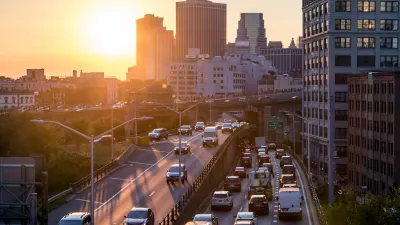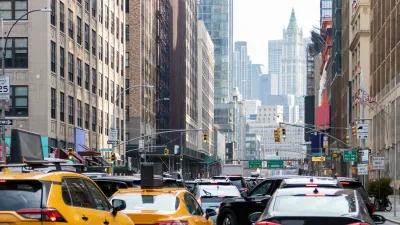In the first of two guest posts, UCLA researcher Eric A. Morris blogs on the logic behind congestion pricing.
"To many people, [congestion pricing] sounds like a scheme by mustache-twirling bureaucrats and their academic apologists to fleece drivers out of their hard-earned cash. Why should drivers have to pay to use roads their tax dollars have already paid for? Won't the remaining free roads be swamped as drivers are forced off the tolled roads? Won't the working-class and poor be the victims here, as the tolled routes turn into 'Lexus lanes'?"
"[Under the current system,] there's no free lunch; instead of paying with money, you pay with the effort and time needed to acquire the good. Think of Soviet shoppers spending their lives in endless queues to purchase artificially low-priced but exceedingly scarce goods. Then think of Americans who can fulfill nearly any consumerist fantasy quickly but at a monetary cost. Free but congested roads have left us shivering on the streets of Moscow."
"Using tolls to help internalize the congestion externality would somewhat reduce the number of trips made on the most congested roads at the peak usage periods; some trips would be moved to less congested times and routes, and others would be foregone entirely. This way we would cut down on the congestion costs we impose on each other."
Thanks to Franny Ritchie
FULL STORY: Why You’ll Love Paying for Roads That Used to Be Free: A Guest Post

Trump Administration Could Effectively End Housing Voucher Program
Federal officials are eyeing major cuts to the Section 8 program that helps millions of low-income households pay rent.

Planetizen Federal Action Tracker
A weekly monitor of how Trump’s orders and actions are impacting planners and planning in America.

Ken Jennings Launches Transit Web Series
The Jeopardy champ wants you to ride public transit.

Rebuilding Smarter: How LA County Is Guiding Fire-Ravaged Communities Toward Resilience
Los Angeles County is leading a coordinated effort to help fire-impacted communities rebuild with resilience by providing recovery resources, promoting fire-wise design, and aligning reconstruction with broader sustainability and climate goals.

When Borders Blur: Regional Collaboration in Action
As regional challenges outgrow city boundaries, “When Borders Blur” explores how cross-jurisdictional collaboration can drive smarter, more resilient urban planning, sharing real-world lessons from thriving partnerships across North America.

Philadelphia Is Expanding its Network of Roundabouts
Roundabouts are widely shown to decrease traffic speed, reduce congestion, and improve efficiency.
Urban Design for Planners 1: Software Tools
This six-course series explores essential urban design concepts using open source software and equips planners with the tools they need to participate fully in the urban design process.
Planning for Universal Design
Learn the tools for implementing Universal Design in planning regulations.
Ada County Highway District
Clanton & Associates, Inc.
Jessamine County Fiscal Court
Institute for Housing and Urban Development Studies (IHS)
City of Grandview
Harvard GSD Executive Education
Toledo-Lucas County Plan Commissions
Salt Lake City
NYU Wagner Graduate School of Public Service





























